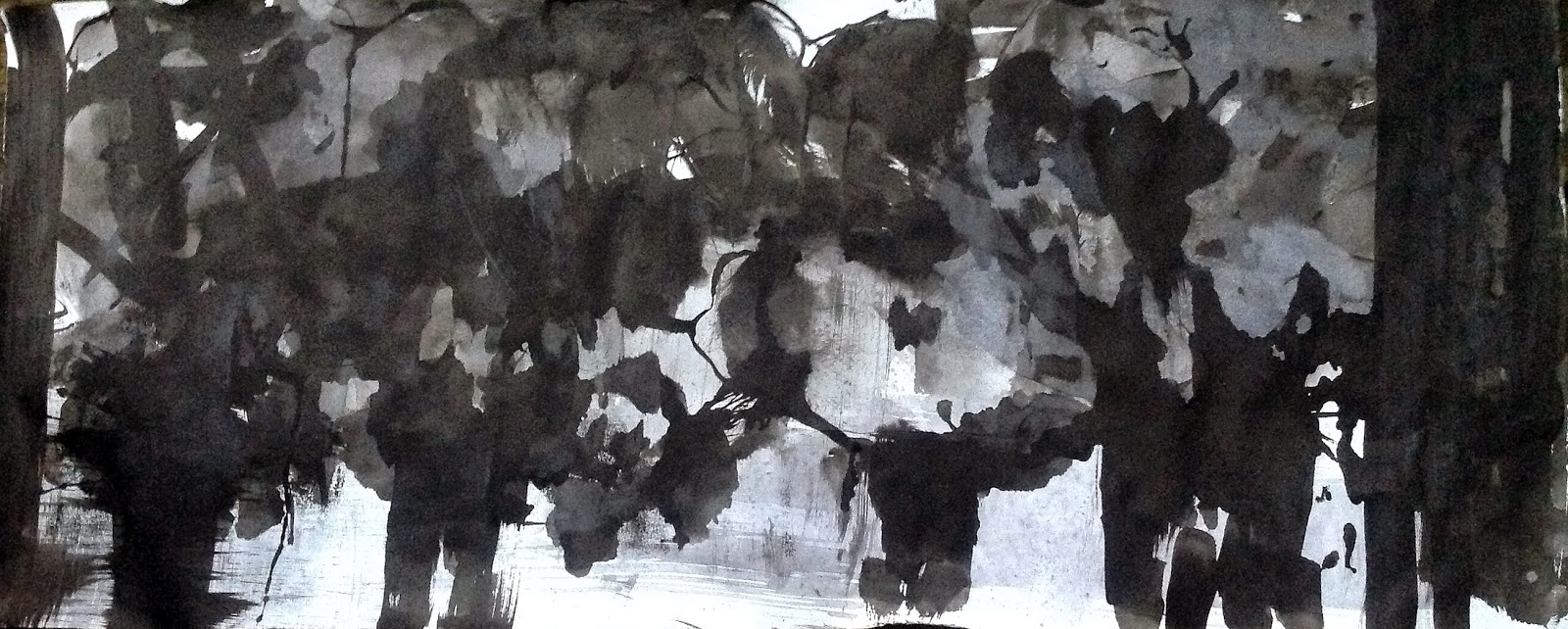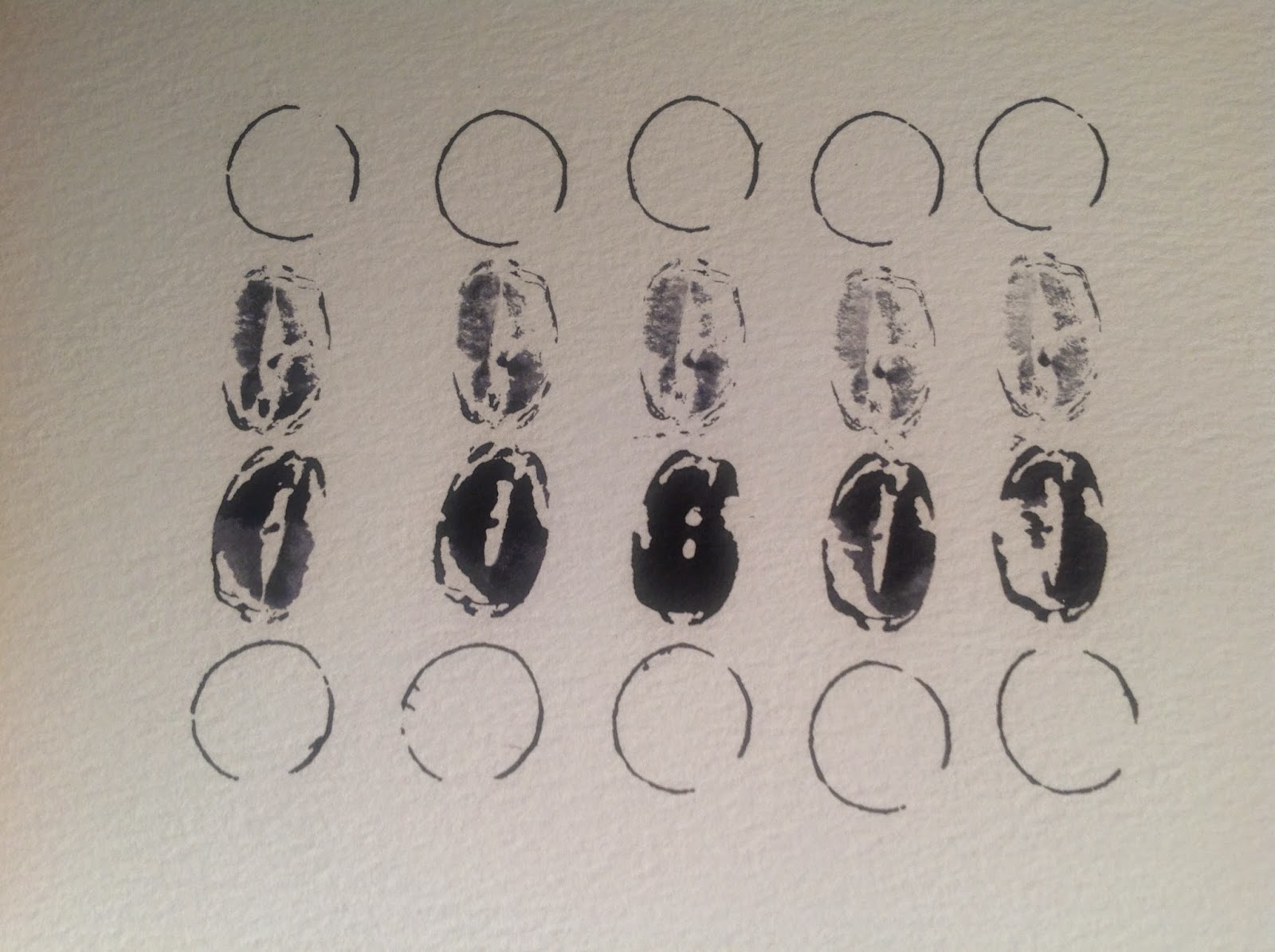Textures created were dependant on the construct of the material which appeared mesh like, highly inflammable and responded very quickly to heat. The process was exciting but I feel is too far outside my 'remit' - it is a separate journey. However, I have thoughts of using larger scale photocopies of this work as a background and creating layers using different media which respond to my initial proposal.
.
Monday, 1 December 2014
Responding to tutorial with Brendan Burns
Relaxed tutorial with Brendan Burns who is a painter. I am having doubts whether I am a painter? Much interaction when viewing my experimental images using paper and ink which showed a variety of approaches - acknowledgement from Brendan that I am a painter! Suggestions that seemed to resonate with me were use of materials. Working on what can be perceived as more 'Western' rigid surfaces were discussed plus my rather persistent habit of working up to an edge of paper, filling the space. Acknowledging comments made re materials I set aside a day for experimenting with more translucent fabrics and found some garden insulating material which is semi-transparent with a fibrous content. This material was light and airy, more flexible and could provide more movement as well as reflecting more traditional Eastern use of materials. Working in the kitchen with this material I used wax resist, tie dying methods to create ground I developed oak leaf forms by melting fabric over heat and applying additional ink in random areas ink as well as cutting and burning into fabric. I found I could also create texture by scrunching material up and placing over direct heat. There were some interesting forms, overlapping of material, melted areas and burn holes all relating very much to decay and the dying process of leaves in autumn. The cut and melted fabric echoed the bark of the tree but in a soft, rather romantic way. The big question was WHY? My answer was the focus on how the material would respond and I felt that I was looking towards creating a layer that could be used to work over with another media. The process was more about the interaction of various elements and resonated more with manipulation of fabric within textile design and I reflected on Sue Bradley's lecture and felt this had influenced me alongside my love of textiles. At present I have no intentions of taking this forward in its present form.
Monday, 17 November 2014
Studio work
Began late in the day so felt pressurised to produce something in a short space of time - culmination was I rushed into work, not giving myself adequate time to plan and think through what media and support I was going to use. The Fabriano paper I have is only 120gsm and therefore ripples and distorts when lots of water applied and I would really like to indulge myself and experiment on much heavier watercolour paper. At this early stage in developing ideas it is not really necessary and would be rather costly.
Although conscious of the limited time I had decided on the format of the support and prepared a long horizontal strip of paper. Applied washes and took blind mono prints along the length and then worked further ink into the designs. Again, this produced a good range of tones and shapes, not a lot of texture, but overall it worked well as a horizontal composition but had lack of space. I felt the image was successful in portraying size and irregular shape of oak trees but felt the light was in the wrong place and overall there was very little depth to the work. I also cropped the image by 25% on the left hand side.
Although conscious of the limited time I had decided on the format of the support and prepared a long horizontal strip of paper. Applied washes and took blind mono prints along the length and then worked further ink into the designs. Again, this produced a good range of tones and shapes, not a lot of texture, but overall it worked well as a horizontal composition but had lack of space. I felt the image was successful in portraying size and irregular shape of oak trees but felt the light was in the wrong place and overall there was very little depth to the work. I also cropped the image by 25% on the left hand side.
Below are two cropped sections from the original work
This image below is the result of drawing different size oak leaves using a cedar bark brush dipped ink. They were small images which were then cut up into various geometric shapes and collage together on one A4 paper. The paper was then cut in half and joined to present as a long horizontal piece. My initial response was that it was rather decorative but upon review I found some interesting qualities, It presents a kind of calligraphic 'tree writing',suggesting its own narrative in relation to leaves and branches of the tree. This could be developed as a long scroll with other elements of the oak tree included - acorns, flowers. The collage itself has too many dividing lines where the paper was cut and I may try to reproduce the image on one long sheet of paper
Finally, a photograph of a favourite item which I have used often to apply both oil and ink to work.This variegated wooden comb creates some wonderful marks and has now become a work of art in itself.
Thursday, 13 November 2014
Experimenting with brush and ink
The following day managed to have an hour or so in the studio experimenting with brush and ink. Using various tones of diluted ink to make a variety of images based on oaks in the landscape. Using watercolour paper of a good weight I used wet into wet, wet on dry, transfer and line. It can be a difficult medium to control, but this is part of its appeal - the unexpected. I used the reverse of the textured paper which was smoother as I did not like the weave type texture. Working on A4 was
restrictive and movement were inevitable tighter - need to work larger. Some good tonal values were achieved in the first landscape image and I felt overall I responded more to shape and space - lots more practice required.
 |
| Are these recognizable as oak trees? I am not sure and feel there are elements of trees growing by water when in fact my intention was to indicate a field in the foreground. |
Saturday, 8 November 2014
Getting to know my object continued
Eventually found time to continue 'getting to know my object'. Having been disappointed with how I had presented the first sketches in my sketch book decided to work on good quality watercolour paper for the second 'batch'. These could then be mounted in the sketch book and be removed easily in order to extend and develop further if required. They could also be mounted with space around each, thus giving them each a more visual identity. I did not adhere so religiously to using Colin Crumplins 'Hommage a Queneau' images as reference. Continuing working with ink only I produced a considerable number of sketches of further components of the oak tree, some of which are shown below.
 |
| The spontaneity and simplicity of this image really captures my imagination |
 |
| This image was worked over and created using layers - very decorative! |
I felt that I had created a diverse and interesting range of imagery using one media. This exercise could be extended much further. Perhaps I could produce a pamphlet book a la Colin Crumplin. So far I have made approx. 36 sketches, so only another 64 to go! It has been a good starting point to this individual area of study. Now I need to get in the studio and start the process and see where it leads - another new journey into the unknown.
Below are three experimental sketches using two colours of ink. Created and presented horizontally I feel they evoke the atmosphere of the oak in Autumn when leaves are changing in colour and falling to the ground. These were created using various methods, blind monoprint, line drawing and overlaying of washes. Quite small in scale I feel they could be developed and extended on a large scale.
A couple of further sketches using ink.
 |
 |
| This was an impromptu moving, accidental photograph of the sketch below - interesting result. |
Thursday, 23 October 2014
Getting to know my object
Now, a few weeks in to term and have at last found time to spend in the studio getting creative. The proposal has been revised and completed. Had a very inspiring tutorial with Angie Cockayne who is just so inspirational and encouraging - its a process in itself! I expressed that I would like to take approach of 'getting to know the object' - the English Oak Quercus Robur, wanting to draw from observation and photographs so as to get to grips with shape and form. This is an approach I have used before during my Foundation Degree when I developing a project around the silver bracelet my mum had given me. Angie suggested I reference Colin Crumplin's 'Hommage a Queneau' a small, concise book, where using pencil only he draws different interpretations of a cup to examine style and meaning. All are drawn on 12" square paper. This references Raymond Queneau who told the same anecdote in ninety nine different ways and Crumplin's book contains 20 selected images of a cup with an inventory of a 100 drawings which are displayed at the end of the publication. I do not intend to do so many images and will execute all drawings in ink. This decision has been made so as to align with my proposal of utilizing traditional Eastern media for creating imagery and keep me from wandering into other expressive media - DISCIPLINE and DEFINING my practice
Below are some of the oak leaf images.
Below are some of the oak leaf images.
Ink drawing using cedar bark brush
Transfer print direct from leaf
Cross hatch drawing
Stippled stencil
Wax resits method
Wet on wet method
Varigated wooden comb
Bark on tree trunk
Wet on wet echoing dimensions of tree
Tree and branch formation using brush and straight edged pen
This is a close up of one of the oak leaf images using combination of ink on wet paper and then a wet wash on left hand side of image. I love the folds on the left.
I was disappointed with my planning when creating images in sketch book, placing four on one page creates confusion. It would have been better to have isolated each image on a separate piece of paper. Also, placing images back to back on sheets of paper was a mistake should I wish to develop individual images in a different way, i.e. cutting and reassembling. Lesson learnt. Having now isolated them in photographic presentation has heightened the different approaches and each now stands in its own space without interference and detraction. I am looking forward to exploring further components using the same media - just wait for the acorns, the whole tree and perhaps the root system!
Subscribe to:
Comments (Atom)















































